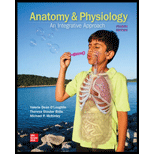
ANATOMY+PHYSIOLOGY-CONNECT ACCESS
4th Edition
ISBN: 9781264265398
Author: McKinley
Publisher: MCG
expand_more
expand_more
format_list_bulleted
Question
Chapter 15.6, Problem 19WDYL
Summary Introduction
To determine:
The possibility for the stimulation of adrenergic receptors to result in either vasodilation or vasoconstriction of the selected vessels of the blood.
Concept introduction:
There are cholinergic as well as adrenergic receptors. The signalling molecules like hormones or neurotransmitters are known as ligands as they get bound to the receptors. The ligands class, which bind to the receptors (adrenergic) in neurons is known as the monoamines or biogenic
Expert Solution & Answer
Want to see the full answer?
Check out a sample textbook solution
Students have asked these similar questions
What symbolic and cultural behaviors are evident in the archaeological record and associated with Neandertals and anatomically modern humans in Europe beginning around 35,000 yBP (during the Upper Paleolithic)?
Describe three cranial and postcranial features of Neanderthals skeletons that are likely adaptation to the cold climates of Upper Pleistocene Europe and explain how they are adaptations to a cold climate.
Biology Question
Chapter 15 Solutions
ANATOMY+PHYSIOLOGY-CONNECT ACCESS
Ch. 15.1 - What criterion is used to organize the nervous...Ch. 15.1 - Prob. 2WDYLCh. 15.1 - What CNS structure is the integration and command...Ch. 15.2 - Prob. 4WDYLCh. 15.2 - Describe the general anatomic differences in the...Ch. 15.2 - Prob. 6WDYLCh. 15.3 - Which four cranial nerves have a parasympathetic...Ch. 15.3 - What organs are innervated by the pelvic...Ch. 15.4 - Prob. 9WDYLCh. 15.4 - Prob. 10WDYL
Ch. 15.4 - Prob. 11WDYLCh. 15.4 - In what ways does the adrenal medulla pathway help...Ch. 15.5 - Prob. 13WDYLCh. 15.5 - Prob. 14WDYLCh. 15.6 - Prob. 15WDYLCh. 15.6 - Prob. 16WDYLCh. 15.6 - Prob. 17WDYLCh. 15.6 - Prob. 18WDYLCh. 15.6 - Prob. 19WDYLCh. 15.7 - Prob. 20WDYLCh. 15.7 - Prob. 21WDYLCh. 15.7 - Prob. 22WDYLCh. 15.7 - What are the body structures innervated by the...Ch. 15.8 - Prob. 24WDYLCh. 15 - A splanchnic nerve in the sympathetic division of...Ch. 15 - Some parasympathetic preganglionic neuron cell...Ch. 15 - Prob. 3DYKBCh. 15 - Prob. 4DYKBCh. 15 - Sympathetic division preganglionic axons travel to...Ch. 15 - Prob. 6DYKBCh. 15 - Prob. 7DYKBCh. 15 - A sympathetic postganglionic axon is a. long and...Ch. 15 - Prob. 9DYKBCh. 15 - Prob. 10DYKBCh. 15 - Prob. 11DYKBCh. 15 - For the following ganglia, identify the location...Ch. 15 - Prob. 13DYKBCh. 15 - Prob. 14DYKBCh. 15 - Prob. 15DYKBCh. 15 - Prob. 16DYKBCh. 15 - Prob. 17DYKBCh. 15 - What may occur with the mass activation of the...Ch. 15 - Prob. 19DYKBCh. 15 - Prob. 20DYKBCh. 15 - Prob. 1CALCh. 15 - Arlene was in a heightened state of alertness well...Ch. 15 - George has hypertension (high blood pressure). His...Ch. 15 - Prob. 4CALCh. 15 - Prob. 5CALCh. 15 - Prob. 1CSLCh. 15 - When you were younger, your parents may have told...Ch. 15 - Prob. 3CSL
Knowledge Booster
Similar questions
- ✓ Details Draw a protein that is embedded in a membrane (a transmembrane protein), label the lipid bilayer and the protein. Identify the areas of the lipid bilayer that are hydrophobic and hydrophilic. Draw a membrane with two transporters: a proton pump transporter that uses ATP to generate a proton gradient, and a second transporter that moves glucose by secondary active transport (cartoon-like is ok). It will be important to show protons moving in the correct direction, and that the transporter that is powered by secondary active transport is logically related to the proton pump.arrow_forwarddrawing chemical structure of ATP. please draw in and label whats asked. Thank you.arrow_forwardOutline the negative feedback loop that allows us to maintain a healthy water concentration in our blood. You may use diagram if you wisharrow_forward
- Give examples of fat soluble and non-fat soluble hormonesarrow_forwardJust click view full document and register so you can see the whole document. how do i access this. following from the previous question; https://www.bartleby.com/questions-and-answers/hi-hi-with-this-unit-assessment-psy4406-tp4-report-assessment-material-case-stydu-ms-alecia-moore.-o/5e09906a-5101-4297-a8f7-49449b0bb5a7. on Google this image comes up and i have signed/ payed for the service and unable to access the full document. are you able to copy and past to this response. please see the screenshot from google page. unfortunality its not allowing me attch the image can you please show me the mathmetic calculation/ workout for the reult sectionarrow_forwardIn tabular form, differentiate between reversible and irreversible cell injury.arrow_forward
- 1.)What cross will result in half homozygous dominant offspring and half heterozygous offspring? 2.) What cross will result in all heterozygous offspring?arrow_forward1.Steroids like testosterone and estrogen are nonpolar and large (~18 carbons). Steroids diffuse through membranes without transporters. Compare and contrast the remaining substances and circle the three substances that can diffuse through a membrane the fastest, without a transporter. Put a square around the other substance that can also diffuse through a membrane (1000x slower but also without a transporter). Molecule Steroid H+ CO₂ Glucose (C6H12O6) H₂O Na+ N₂ Size (Small/Big) Big Nonpolar/Polar/ Nonpolar lonizedarrow_forwardwhat are the answer from the bookarrow_forward
arrow_back_ios
SEE MORE QUESTIONS
arrow_forward_ios
Recommended textbooks for you
 Human Physiology: From Cells to Systems (MindTap ...BiologyISBN:9781285866932Author:Lauralee SherwoodPublisher:Cengage LearningBasic Clinical Lab Competencies for Respiratory C...NursingISBN:9781285244662Author:WhitePublisher:Cengage
Human Physiology: From Cells to Systems (MindTap ...BiologyISBN:9781285866932Author:Lauralee SherwoodPublisher:Cengage LearningBasic Clinical Lab Competencies for Respiratory C...NursingISBN:9781285244662Author:WhitePublisher:Cengage Biology: The Unity and Diversity of Life (MindTap...BiologyISBN:9781305073951Author:Cecie Starr, Ralph Taggart, Christine Evers, Lisa StarrPublisher:Cengage Learning
Biology: The Unity and Diversity of Life (MindTap...BiologyISBN:9781305073951Author:Cecie Starr, Ralph Taggart, Christine Evers, Lisa StarrPublisher:Cengage Learning Comprehensive Medical Assisting: Administrative a...NursingISBN:9781305964792Author:Wilburta Q. Lindh, Carol D. Tamparo, Barbara M. Dahl, Julie Morris, Cindy CorreaPublisher:Cengage Learning
Comprehensive Medical Assisting: Administrative a...NursingISBN:9781305964792Author:Wilburta Q. Lindh, Carol D. Tamparo, Barbara M. Dahl, Julie Morris, Cindy CorreaPublisher:Cengage Learning

Human Physiology: From Cells to Systems (MindTap ...
Biology
ISBN:9781285866932
Author:Lauralee Sherwood
Publisher:Cengage Learning


Basic Clinical Lab Competencies for Respiratory C...
Nursing
ISBN:9781285244662
Author:White
Publisher:Cengage


Biology: The Unity and Diversity of Life (MindTap...
Biology
ISBN:9781305073951
Author:Cecie Starr, Ralph Taggart, Christine Evers, Lisa Starr
Publisher:Cengage Learning

Comprehensive Medical Assisting: Administrative a...
Nursing
ISBN:9781305964792
Author:Wilburta Q. Lindh, Carol D. Tamparo, Barbara M. Dahl, Julie Morris, Cindy Correa
Publisher:Cengage Learning